Fence and Deck Staining Denver, CO
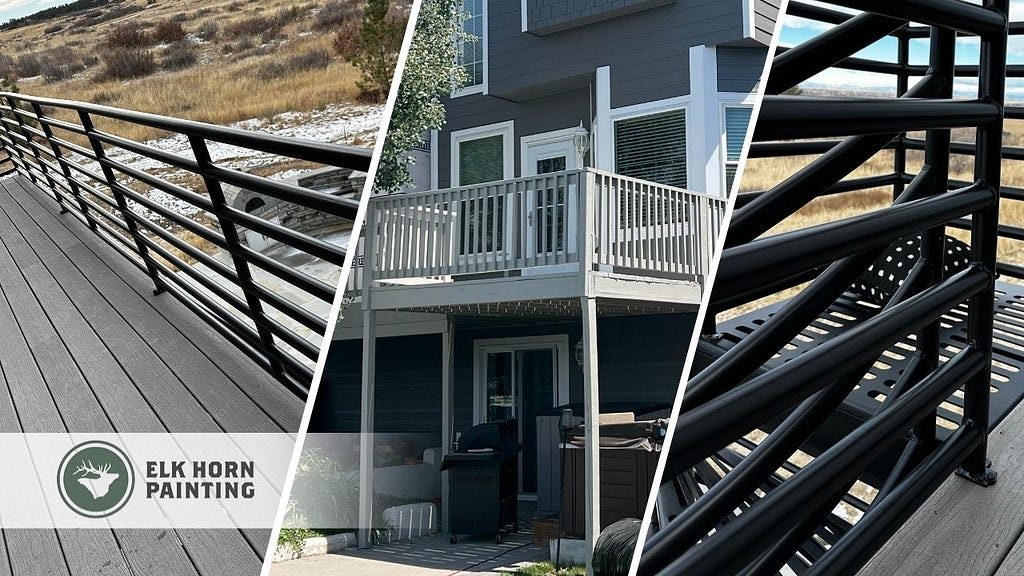
Fence and deck staining is more than a cosmetic upgrade — it’s a critical defense against Colorado’s unpredictable climate. In Denver, outdoor wood surfaces endure intense sun exposure, heavy snow, fluctuating temperatures, and dry air that can quickly deteriorate unprotected lumber. Staining creates a protective barrier that shields wood from UV damage, moisture intrusion, and cracking caused by freeze-thaw cycles.
Beyond protection, staining enhances the natural beauty of wood, highlighting its grain and deepening its color. It gives fences and decks a clean, well-maintained appearance while extending their usable life by several years. Unlike paint, which can chip, peel, and trap moisture beneath the surface, stain penetrates the wood, allowing it to breathe and resist damage from within.
In the Denver area, common wood types like cedar, redwood, and pressure-treated pine are popular for fencing and decking. While these species are naturally resilient, they still require regular staining to prevent graying, warping, and rot. Leaving them untreated invites premature wear and costly repairs. For homeowners who want long-term performance and curb appeal, professional fence and deck staining in Denver CO is not optional — it’s essential.
How Fence and Deck Staining Protects Your Wood in Denver
Denver’s climate poses unique challenges for outdoor wood. With over 300 days of sun, rapid temperature swings, and seasonal snow, wood is constantly expanding, contracting, and absorbing environmental stress. Without protection, this leads to fading, warping, cracking, and decay.
Fence and deck staining creates a moisture-resistant, UV-blocking barrier that shields the wood from damage. Stains help prevent water from seeping into the grain, reducing the risk of mold, mildew, and rot — especially during freeze-thaw cycles where trapped moisture can cause structural splitting. They also guard against the bleaching effect of high-altitude sunlight, helping to preserve the wood’s natural color and texture.
Clear stains offer minimal color change while providing basic protection, semi-transparent stains balance appearance with durability, and solid stains deliver maximum coverage and long-term defense. Each option plays a role depending on the condition of the wood and the level of exposure. In Denver, staining is not just aesthetic — it’s vital for protecting wood year-round.
Choosing the Right Stain for Your Fence or Deck
Selecting the right stain for your fence or deck is crucial for achieving both long-lasting protection and the look that complements your home. In Denver’s high-altitude environment, where UV exposure is intense and the weather shifts rapidly between hot, dry days and freezing temperatures, stain performance matters just as much as appearance.
Types of Stains
Each type of stain offers a different level of coverage, durability, and visual effect:
- Transparent stains provide the most natural look, allowing the full grain and texture of the wood to show through. Best suited for new, high-quality wood, they offer light UV and moisture protection but require more frequent reapplication.
- Semi-transparent stains add subtle color while still revealing the wood’s character. They strike a balance between aesthetics and protection, making them a popular choice for fences and decks in good condition.
- Solid stains resemble paint in appearance, offering full color coverage and the highest level of UV and moisture resistance. These are ideal for aging or weathered wood, where hiding imperfections is a priority.
Oil-Based vs. Water-Based Stains
The type of stain base affects durability, application, and environmental impact:
- Oil-based stains penetrate deeply, providing long-lasting protection and a rich finish. They are well-suited to Denver’s dry climate but take longer to dry and emit higher VOCs.
- Water-based stains dry faster, are more environmentally friendly, and clean up easily with soap and water. While they don’t penetrate as deeply, advances in formulation have made them more durable than in the past — especially important in neighborhoods with air quality considerations.
Stain Considerations for Denver Homes
When choosing a stain, it’s important to factor in local variables:
- Elevation increases UV intensity, so UV-blocking protection is critical, even with semi-transparent or clear stains.
- HOA guidelines may limit stain color options or require approval for visible exterior changes. Always check your neighborhood’s rules before selecting a bold or opaque finish.
- Home style and architecture play a role in stain choice. Rustic homes often benefit from transparent or semi-transparent finishes that highlight wood grain, while contemporary designs may call for bold, solid-color stains that coordinate with trim and siding.
Choosing the right stain isn’t just about color — it’s about selecting the formula that will hold up in Denver’s climate and meet the unique demands of your home and neighborhood. A well-matched stain will enhance your property’s look while protecting it from costly weather-related damage.
Additionally, consider how traffic patterns and sun exposure differ on horizontal deck boards versus vertical fence panels. Horizontal surfaces take more wear and exposure, often requiring more durable or darker-toned stains to maintain performance and appearance. These areas are also more prone to moisture accumulation and surface breakdown, making stain choice critical.
In high-use zones — like stairs, landing areas, and south-facing deck boards — using a high-penetration oil-based or solid stain can help extend the maintenance cycle. On fences, especially shaded or north-facing ones, mildew resistance and UV protection are priorities.

How Professionals Stain Fences and Decks in Denver CO
A long-lasting, high-quality finish starts well before the stain is applied. Professional fence and deck staining in Denver CO follows a proven process that ensures maximum protection and performance — especially important in a climate known for its extreme sun, dry air, and abrupt weather shifts.
Surface Preparation Is Non-Negotiable
Prep work is one of the most overlooked steps in DIY staining — and it’s where professional results start to stand out. Experts begin by thoroughly cleaning the wood to remove dirt, mildew, and old stain or sealant. This is often done with a commercial-grade power washer and eco-friendly cleaners designed for wood surfaces. After cleaning, the wood must be allowed to dry completely — typically 24 to 48 hours depending on humidity and exposure.
Once dry, the surface is sanded or lightly etched to open up the wood grain. This allows the stain to absorb evenly and deeply, which directly affects how well it protects the surface.
Timing and Weather Conditions in Denver
Denver’s altitude and arid conditions make timing critical. The ideal window for staining is late spring through early fall, when temperatures range between 50°F and 90°F and rain is not in the forecast. Professionals monitor moisture levels, UV index, and temperature to ensure conditions are optimal for both application and curing.
Applying stain in direct, midday sun can cause it to flash-dry on the surface before it penetrates — leading to uneven results. Experienced contractors work in shaded areas when possible and adjust their schedule around the sun’s movement and weather changes.
Avoiding Common DIY Mistakes
Many DIY staining jobs fail because of:
- Inadequate prep (dirty, damp, or unsanded wood)
- Rushed application in poor weather
- Over-application leading to sticky residue
- Uneven coating due to poor tool choice
Tools and Application Methods
Professionals use a combination of tools depending on the project and stain type:
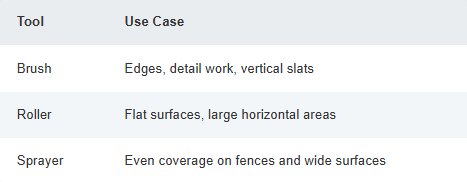
Sprayers offer speed and efficiency for large surfaces but require skill to avoid overspray and streaking. Rollers and brushes are used for precision and to push stain deep into the grain, especially important for dense or weathered wood.
Pros often combine these tools for best results — for example, spraying the stain, then back-brushing to ensure even absorption.
Each tool plays a role in optimizing coverage and ensuring the stain adheres properly to the surface. In Denver’s dry air and intense sunlight, getting the stain deep into the wood grain is essential to prevent premature wear and uneven fading. Professionals often tailor tool use to the wood species, surface orientation, and age of the structure.
For example, a weathered cedar fence might require heavy brushing to reach deeper fibers, while a newer pine deck may respond best to a combination of spraying and back-brushing. This strategic use of tools contributes directly to stain longevity and overall finish quality.
Professionals avoid these mistakes through disciplined prep, weather-aware timing, and proven technique. The result is a uniform, deep-penetrating finish that resists Denver’s harsh conditions and extends the life of your fence or deck for years.
Fence and Deck Staining Costs in Denver CO
Professional fence and deck staining in Denver CO typically ranges from $2.00 to $4.50 per square foot, depending on several key factors: the condition of the wood, the type of stain selected, the amount of surface preparation required, and the complexity of the project. While this upfront investment may seem significant, it is far more cost-effective over time than alternatives like painting or full wood replacement.
For example, a small fence around 100 linear feet might cost between $500 and $1,000, assuming minimal cleaning and a standard semi-transparent stain. A medium-sized deck of 300 square feet may fall between $900 and $1,350, while a larger project that combines a 600-square-foot deck with 200 linear feet of fencing could range from $2,000 to $3,000, particularly if the wood is weathered or previously stained. Projects that require heavy prep — like stripping old paint, sanding warped boards, or replacing rotted sections — will fall at the higher end of the range.
One of the biggest financial advantages of staining is its durability and low maintenance profile. Unlike paint, which can peel, crack, and trap moisture underneath its surface, stain penetrates the wood, allowing it to breathe. This not only prevents premature damage but also simplifies upkeep. With proper maintenance, a high-quality stain can last 2 to 5 years before needing a recoat, depending on sun exposure and weather conditions. Touch-ups are simple, and don’t require the same level of prep as a failing paint job.
In contrast, painting may offer a clean initial look but often requires full stripping and repainting every 2 to 3 years in Denver’s harsh environment. That adds significant cost and labor over time. Replacement is even more expensive, with full tear-outs and rebuilds easily costing five to ten times more than a professional staining job.
Staining also adds value beyond protection. A well-maintained fence or deck enhances curb appeal and can be a selling point for potential buyers. Real estate agents often highlight well-finished outdoor spaces as lifestyle features that influence home value. Additionally, homeowners associations in many Denver neighborhoods expect outdoor wood structures to be regularly maintained, and proper staining ensures compliance.
For multi-family properties or commercial spaces, regular staining can also reduce liability. Slippery, weather-worn deck boards or splintering fences present risks to tenants, customers, or visitors. Maintaining these surfaces with routine staining keeps them safer, compliant with building standards, and reduces long-term repair and legal costs.
Investing in professional fence and deck staining in Denver CO delivers both immediate results and long-term savings. It extends the life of your wood, protects against costly weather damage, and avoids the high expenses associated with neglect or improper maintenance. When done right, staining is not just a surface treatment — it’s a smart financial decision.
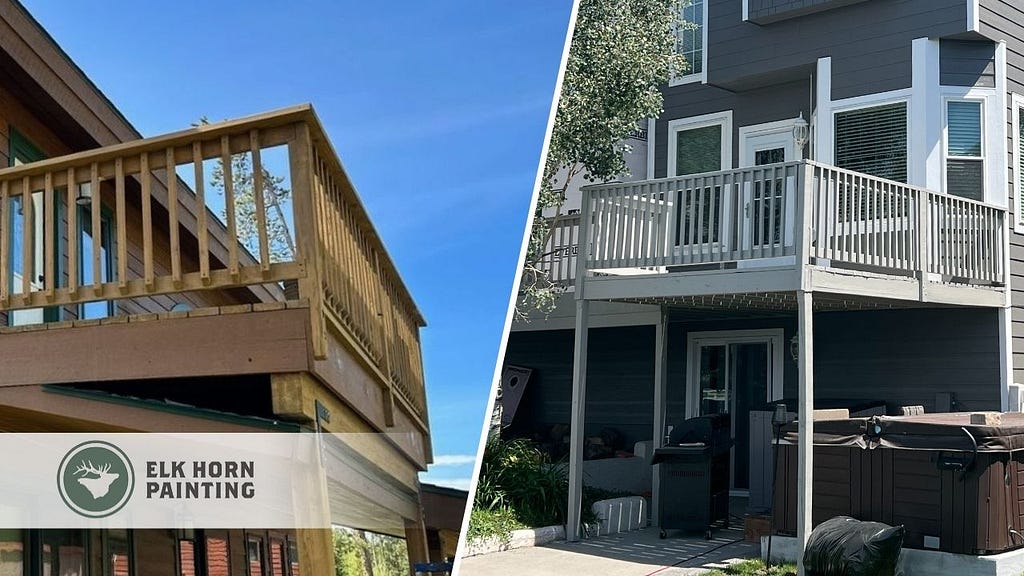
Eco-Friendly Staining Options for Fences and Decks in Denver
Staining your fence or deck doesn’t have to come at the expense of your health or the environment. In Denver, where environmental responsibility and air quality are ongoing concerns, many homeowners are turning to eco-friendly staining solutions that offer both performance and sustainability. These products use low- or zero-VOC (volatile organic compound) formulas, biodegradable ingredients, and safer solvents that reduce environmental impact without sacrificing durability.
Low-VOC and Non-Toxic Stain Options
Traditional oil-based stains often contain high levels of VOCs, which contribute to air pollution and can be harmful when inhaled. Modern alternatives include water-based and plant-based stains that emit little to no fumes and are safe for children, pets, and nearby plants. Many of these stains are designed to meet or exceed air quality standards in states like Colorado, where outdoor ozone levels can already be high.
Recommended Eco-Friendly Stain Products
Several high-performance products available in the Denver area balance eco-consciousness with weather durability:
- DEFY Extreme Wood Stain (water-based, low-VOC, UV-blocking)
- Timber Pro UV Natural Stain (plant-oil-based, biodegradable)
- Eco Wood Treatment (non-toxic, mineral-based, no reapplication needed)
- Penofin Verde (natural oils, certified by multiple green standards)
These stains are designed for high-altitude environments and perform well in Colorado’s sun and snow, providing long-term protection with minimal environmental footprint.
Safe Cleanup and Responsible Use
Eco-friendly staining also extends to how products are used and disposed of:
- Use drop cloths to prevent runoff into soil or storm drains.
- Clean tools with biodegradable soaps instead of chemical solvents.
- Properly dispose of rags and containers at local hazardous waste facilities.
- Avoid staining during high wind or just before rainfall to prevent drift and runoff.
Eco-Certifications and Standards
Look for stains that carry third-party certifications verifying their environmental claims. These labels ensure the product meets rigorous standards for human health and ecological safety.

These certifications give peace of mind that your stain choice aligns with sustainable building practices and contributes to cleaner air and soil.
Tips for Sustainable Staining in Denver
- Choose lighter-colored stains to reflect heat and extend wood life.
- Buy only what you need to reduce waste.
- Store leftovers properly for future touch-ups instead of discarding them.
- Work during cooler hours of the day to reduce fast drying and unnecessary waste.
Eco-friendly fence and deck staining in Denver is not just a trend — it’s a practical response to local climate and community values. With the right products and practices, you can protect your outdoor wood structures while doing your part to preserve Colorado’s natural environment.
How to Maintain a Stained Fence or Deck Year-Round in Colorado
Maintaining a stained fence or deck in Colorado requires consistent care, especially with the state’s variable seasons and high UV exposure. With Denver’s strong sun, dry winters, and frequent freeze-thaw cycles, stain maintenance isn’t just about looks — it’s essential to preserving the integrity of your wood surfaces and protecting your investment.
Seasonal Maintenance Tasks
Colorado’s climate calls for a seasonal maintenance routine to prevent premature wear and extend the life of your stain:
Spring
- Rinse off winter debris using a gentle power wash or hose with a soft-bristle brush
- Inspect for cracking, mildew, peeling, or water absorption
- Apply wood cleaner or brightener if needed before restaining or touch-ups
Summer
- Check for UV fading and drying, especially on south- or west-facing surfaces
- Touch up areas with light wear using the same stain used previously
- Ensure nearby sprinklers or irrigation aren’t soaking the wood regularly
Fall
- Remove leaves, dirt, and organic buildup that can trap moisture
- Recheck surface condition before snow season
- Apply a fresh coat of stain if signs of breakdown appear
Winter
- Shovel snow promptly from decks to prevent moisture saturation
- Avoid using harsh de-icing chemicals on stained surfaces
- Visually inspect when safe to access, especially after storms
When to Re-Stain Based on Exposure and Wear
Not all fences and decks require the same re-staining schedule. Sun exposure, foot traffic, and moisture levels all affect how long a stain lasts. In Denver’s climate:
- Horizontal surfaces like decks may need re-staining every 2–3 years
- Vertical surfaces like fences can last 3–5 years with quality stain
- Signs it’s time to re-stain include fading, water no longer beading, splintering, or visible graying
Conduct a quick water test — sprinkle a small amount of water on the surface. If it soaks in rather than beading up, the wood is ready for a new coat.
Recommended Maintenance Products
To maintain your stained surfaces between full applications, use products designed to protect and refresh:
- DEFY Wood Brightener — Restores color and preps for new stain
- Thompson’s WaterSeal Cleaner & Enhancer — Great for annual cleaning and UV protection
- DeckWise Cleaner and Mild Brightener Kit — Eco-safe and effective for decks and fences
- OxiClean Outdoor Cleaner — Non-toxic solution for removing surface stains and mildew
Staying ahead of Colorado’s climate with seasonal maintenance and the right products helps ensure your stained fence or deck looks great and performs well for years.
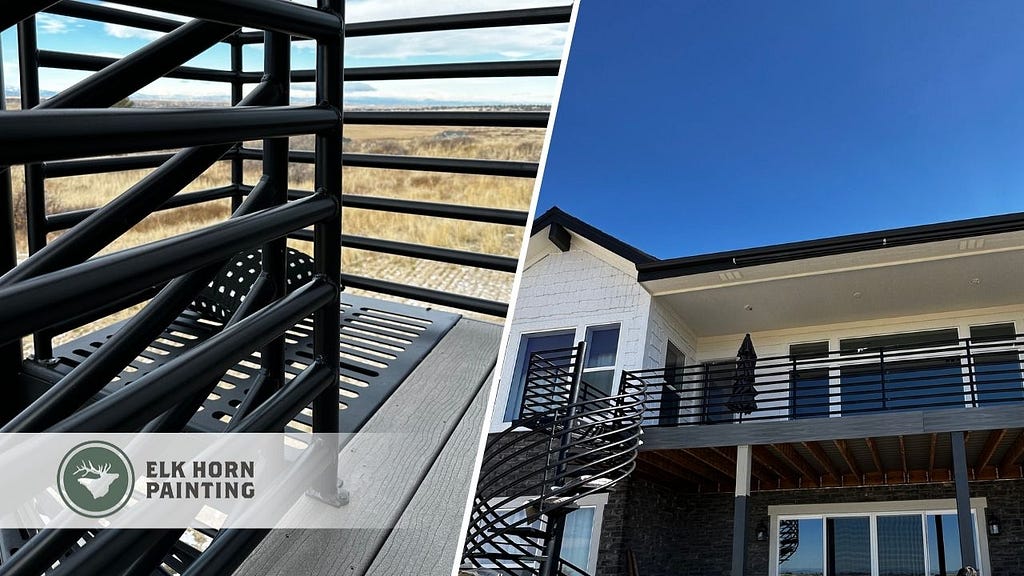
7 Signs Your Deck or Fence Needs Attention
Even the best stain won’t last forever — especially in Colorado’s tough climate. Between intense sun exposure, snowfall, and frequent freeze-thaw cycles, wood structures like fences and decks are constantly under stress. Knowing when to re-stain can save you from costly repairs and protect your investment for the long term.
Common Signs Your Stain Is Failing
There are several reliable visual and structural indicators that your stain is no longer doing its job:
- Fading or graying of the wood, especially in sun-exposed areas
- Peeling or flaking of the existing stain, often on horizontal surfaces
- Rough or splintering texture that wasn’t there before
- Water absorption where rain or hose water soaks in rather than beads up
- Dark spots or mold growth, particularly in shaded or damp areas
- Cracks or warping in the wood boards
- Loss of color richness or uneven appearance
These changes signal that the protective barrier created by the stain has worn down, leaving your wood exposed to moisture and UV damage.
Consequences of Delaying Re-Staining
- Ignoring the signs of wear can quickly lead to bigger issues:
- Moisture penetration can cause rot, mildew, or insect infestation
- Sun damage leads to weakened fibers, splintering, and discoloration
Quick Test: Is the Stain Still Working?
Performing a simple water test can help determine if your stain still provides protection:
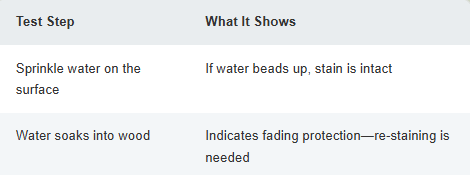
Conduct this test on multiple sections, especially in high-traffic or sun-exposed areas like deck boards and top fence rails.
In Denver, where the climate accelerates wear, letting stain maintenance lapse even one or two seasons can reduce the life of your fence or deck by years. Once wood begins to degrade, even the best stains can’t reverse the damage — only preserve what’s left.
This is especially true for horizontal deck boards, which take the brunt of UV exposure, foot traffic, and snow accumulation. Boards that are softening, warping, or separating from fasteners are not just a cosmetic issue — they’re a safety concern. Similarly, fence posts that absorb too much moisture may begin to lean or rot at the base.
Catching these problems early through routine inspections and timely re-staining can prevent structural failure and help avoid large-scale replacements. Regular upkeep is both cost-effective and essential for preserving the strength, appearance, and safety of your outdoor wood features.
FAQs About Fence and Deck Staining in Denver CO
When is the best time to stain a fence or deck in Denver?
Late spring through early fall is ideal, when temperatures stay between 50°F and 90°F with low humidity. Avoid staining in direct sunlight or right before rain. Mornings or shaded periods are best to prevent premature drying and ensure proper stain absorption.
Can you stain over an old stain?
Yes, but only if the existing stain is not peeling or flaking. For semi-transparent or transparent stains, the same or darker color should be used. Solid stains can cover most previous finishes. Proper cleaning and light sanding ensure adhesion and even coverage.
What’s the difference between oil-based and water-based stains?
Oil-based stains penetrate deeper and last longer, making them ideal for dry climates like Denver. They take longer to dry and have higher VOCs. Water-based stains are more eco-friendly, dry faster, and are easier to clean up but may require more frequent reapplication.
How long does stain take to dry and fully cure?
Most stains dry to the touch in 4–8 hours, depending on humidity and temperature. However, full curing can take 24–72 hours. Avoid heavy foot traffic, furniture placement, or exposure to moisture until the stain has completely cured to prevent blotching or damage.
Are wood stains safe for kids, pets, and gardens?
Low-VOC and water-based stains are generally safe once fully cured. During application and drying, keep children and pets away from the area. Avoid staining near edible gardens or use protective barriers. Always check product labels for toxicity and environmental safety certifications.
Get a Free Estimate for Fence and Deck Staining in Denver CO
Protecting your fence or deck with expert staining helps prevent weather damage, enhances curb appeal, and extends the life of your outdoor wood. Professional application ensures even coverage, proper adhesion, and long-lasting results — especially important in Denver’s challenging climate. Elk Horn Painting — Denver delivers high-quality staining services using premium products, tailored to Colorado’s conditions and your property’s unique needs. Whether you have a new installation or weather-worn surfaces needing restoration, our experienced team offers the skill and care required for a durable, attractive finish.
For expert local service and a free quote, call Elk Horn Painting — Denver at (970) 578–3994.
from Stories by Elk Horn Painting - Denver on Medium https://medium.com/@elkhornpaintingdenver/what-makes-fence-and-deck-staining-a-must-in-denvers-climate-c58e2c769161?source=rss-7e857c77e470------2
via Elk Horn Painting - Denver
No comments:
Post a Comment